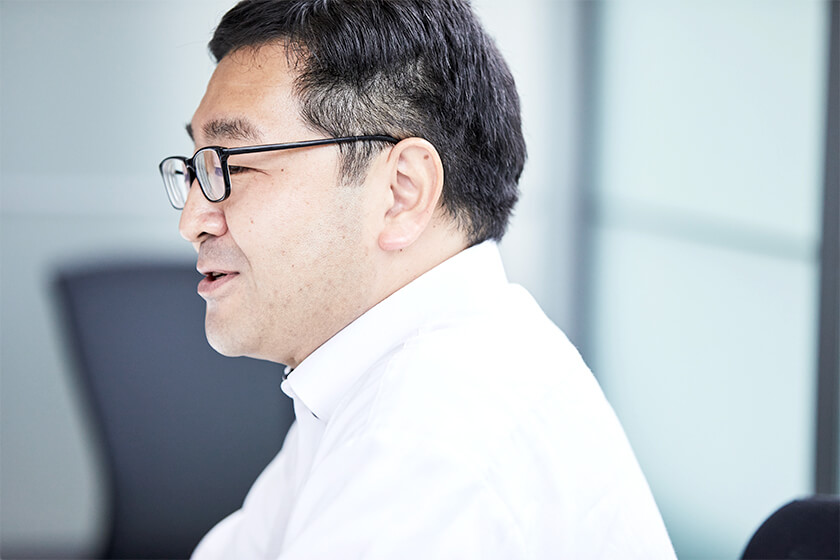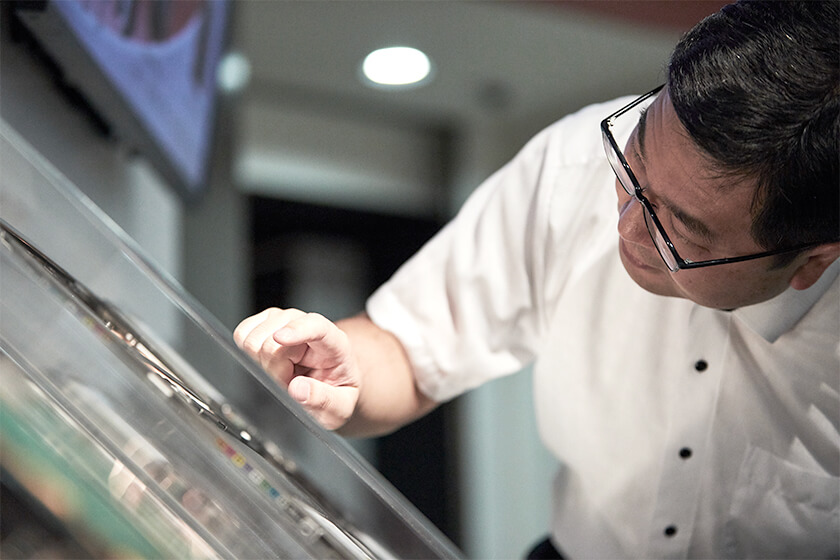
(Continued from Part 1)
The supercomputer Fugaku , which has inherited the design assets of the K computer and evolved further, moved into the pre-operation phase in FY2020 to conduct research on COVID-19 infection control measures. The K computer and Fugaku were developed not only to solve problems of huge sizes but also to facilitate use by researchers in a variety of fields.
In Part 2 of our exploration of the development of Fugaku, we interview Yuichiro Ajima, the developer who invented the six-dimensional interconnect technology and introduced two generations of supercomputers to the world. We talk about how he overcame significant hurdles during the development process, his current thinking, and the performance that can be expected from the supercomputer Fugaku.
Jump to:
- Unexpected adoption
- Increasing the number of viewpoints
- Responsibility for Technology
- Fugaku’s power
- Tackling COVID-19 challenges and social issues
- Supercomputers must evolve into the future
- Routine advance preparation will help us in difficult situations
Unexpected achievement
Ajima: I think the greatest factor behind the successful development of six-dimensional interconnect technology is the success of the K computer development project, in which we were blessed with a good environment, leaders, and team. At the start of the project, I never expected that six-dimensional interconnect technology could be achieved. It was also fortunate that, at the end of the conceptual design, the performance was enhanced to a level that we could be proud of as a Fujitsu product.
Increasing the number of viewpoints
Ajima: In the conceptual design phase, there were many different opinions and requirements, which was overwhelming. It was tricky but we did our best to use technologies to address the challenges. To figure out possible solutions, I tried to bring back things that seemed to be technically impossible. I repeated this process again and again.

Getting as many viewpoints as possible helped clarify the issue and led to the solution. I placed importance on listening to many people, especially those who seldom spoke up. When I talked to people who were just thinking and watching the progress, I found they often had insights about matters that they were not in charge of, as well as viewpoints I had never thought about.
Responsibility for Technology
Ajima: The team respected each member’s autonomy. Our boss presented the minimum requirements and otherwise encouraged them to solve the problem the way they came up with it. This way, our boss made it clear that the developers were responsible for the technology while he was responsible for the product and the business. This freed me up to do my best work as a developer.

If each person's work is left to their own discretion, quality improves, and they become more aware of the consistency between the parts that they are working on and other related parts. I felt that clearly limiting the scope of "responsibility" to "technology," made our work easier to do. I learned how hundreds of people working on the same project in Fujitsu’s business unit. This helped me carry through to the very end without giving up because I was given responsibility and discretion, which gave me a sense of loyalty to the project.
Fugaku’s power
Ajima: The development of Fugaku’s basic design began in 2014. Delivery started in December 2019 and was completed in May 2020. Fugaku was developed based on the design assets of the K computer; however, the major difference between the two is that the memory and processor, which were separate in the K computer, are integrated into a single unit in Fugaku by heterogeneous integration packaging technology.
Fugaku adopts optical connection instead of electrical connection, and it has a fault-recovery mechanism that provides fault resistance and tolerance as well as a self-recovery capability. Its increase in density is four times that of K. After I made the first push, the rest was developed like a snowball that grew bigger and bigger with the cooperation of the other team members.

The CPU memory unit of PRIMEHPC FX1000 (commercial supercomputer) using Fugaku technology
When comparing the theoretical peak performance of a single rack (case) of Fugaku with the K computer, Fugaku's computing performance, memory bandwidth, and interconnect bandwidth are equivalent to 80 racks, 64 racks, and 8 racks of the K computer, respectively.
Generally, due to the miniaturization of semiconductor devices, even if computing performance improves, the input-output bandwidths such as memory bandwidth and interconnect bandwidth do not increase very much. Fugaku is remarkable in that it has achieved a significant increase in memory bandwidth. Heterogeneous integration packaging technology contributed to the improvement in memory bandwidth. Fugaku has also achieved the world's highest level of power consumption efficiency and improved application execution performance by up to 100 times or more.
Tackling COVID-19 challenges and social issues
Ajima: I hope that Fugaku will be used to contribute to science and technology research in Japan. Fugaku is already being used to research issues related to COVID-19 with efforts focused on five carefully selected fields, such as the development of therapeutic drugs and the simulation of infections caused by the pandemic. I hope that Fugaku will make numerous achievements.

<Five research topics for COVID-19 measures using Fugaku.>
1) Exploring new drug candidates for COVID-19 (Dr Yasushi Okuno, RIKEN/Kyoto University), 2) Prediction of conformational dynamics of proteins on the surface of SARS-CoV-2 (Dr Yuji Sugita, RIKEN), 3) Simulation analysis of pandemic phenomena (Dr Nobuyasu Ito, RIKEN), 4) Fragment molecular orbital calculations for COVID-19 proteins (Dr Yuji Mochizuki, Rikkyo University), 5) Prediction and countermeasure for virus droplet infection in the indoor environment (Dr Makoto Tsubokura, RIKEN/Kobe University).
The nine priority issues to be tackled using Fugaku include:
- drug discovery and medicine
- solving problems in modern society related to disasters, the global environment, and energy sustainability
- innovative manufacturing
- solving the mysteries of the universe and life
- research on AI and robotics to help address other issues.
Supercomputers must evolve into the future
Ajima: The K computer and Fugaku were developed just when large-scale data center technologies, such as cooling technology, were coming to the fore. Thus, supercomputers could make the most of that trend. As more and more diverse users share a massive supercomputer, the load is equalized and operational efficiency is increased, just like a whole data center. About 20 years ago, it seemed that all computers would become personal computers; however, the current trend is cloud computing, which uses data stored at data centers in the cloud to conduct calculations that cannot be handled by personal computers.

Going forward, I want to continue to evolve Fujitsu's computer hardware technologies. I participate in working groups and discuss with young researchers and developers from many companies to research what type of calculations will be needed in future and to further discuss what kind of computers we should develop. I hope these efforts will lead to the development of future supercomputers, including the successor to Fugaku. The current patent on "Tofu interconnect" six-dimensional interconnect technology will expire in 2028. So, I hope I will have another opportunity to work on a new architecture around that time.
Routine advance preparation will help us in difficult situations
Ajima: We innovated in response to demand and because we did not want to say anything was technically impossible. We cannot know whether we are shortsighted or whether it is technically impossible without knowing the real world from a broad perspective. Therefore, I think that it’s important for us to prepare in advance as a matter of routine.

My advice to those who want to achieve innovation is to learn not only the technologies in your field but also those outside your field, including peripheral technologies, and grasp cutting-edge technologies. Innovation will be more successful when researchers and developers enjoy the deep world of technology by coming to know multiple technologies, reading articles, accessing primary information, and thinking about the backgrounds of their developers.
Profile
Yuichiro Ajima
Principal Architect (Interconnect Architecture)
System Development Division, Platform Development Unit
Fujitsu Limited

1997: Graduated from the Department of Electrical Engineering, The University of Tokyo.
2002: Completed the Doctoral Program in Information Engineering, Graduate School of Engineering, The University of Tokyo, PhD (Engineering).
2002: Joined Fujitsu Laboratories.
2007: Transferred to a division at Fujitsu Limited and developed interconnects for the K computer and Fugaku.
2012: Won the Ichimura Prize in Industry for Distinguished Achievement.
2014: Won the Imperial Invention Prize, the National Commendation for Invention.
2017: Won the Prize for Science and Technology, Commendation for Science and Technology by the Minister of Education, Culture, Sports, Science and Technology.
2020 (Spring): Awarded the Medal with Purple Ribbon.












